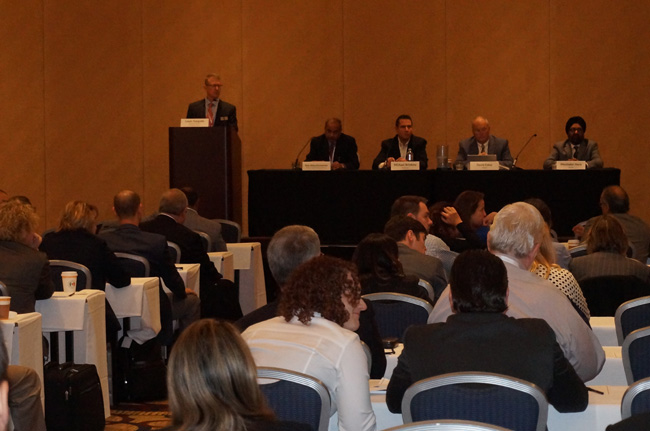The Global CMO Wars: No More Us Vs. Them (Part 1)

By Louis Garguilo, Chief Editor, Outsourced Pharma

Us and Them … and after all we're only ordinary men.
Black and Blue … and who knows which is which and who is who.
-- from Pink Floyd’s “Us and Them”
It’s said I have a voice for radio. Actually, my radio days ended swiftly when fired from a university station for refusing to interrupt the album “Dark Side of The Moon” for FCC-mandated station identifications. (Ahh … the (misguided) principles of youth.)
I was reminded of the above lyrics and that abbreviated career during the electric, two-day Outsourced Pharma San Francisco conference, where among other topics, the audience and panelists wrestled with the prevailing attitude of us vs. them in the global outsourcing service industry. Us vs. them not as in sponsors (virtual companies and start-ups, biotechs, pharma) versus service providers (contract research, development and manufacturing organizations). Rather, as factions within the service sector, where dividing lines are drawn between the domestics (U.S.- or more broadly Western-based) and the internationals (Asia-based, including India).
A (manipulative) moderator for the opening panel immediately threw the conference into this fray. The intention was to fully expose the fissure, test the veracity of the attitudes that maintain it, and perhaps affect some attitudinal change. The initial component chosen for this deed was cold hard cash, i.e., specific global pricing of services, and how that pricing is interpreted.
This first article relates some of that unusually detailed discussion of money in the outsourcing industry. And like that album of long ago mentioned above, playing all of the us vs. them music at Outsourced Pharma San Francisco will take two sides, this and a following article … with the requisite station identifications, of course.

The Battle Of The Budget
The tone was set from the first words of the conference, delivered by the moderator (and slightly abridged here):
“We’ll try something new for a conference: We’ll use real numbers, and talk specific pricing. Quality, reliability, relationships and value are all important. But numbers matter. And yet we don’t publicly talk about them. How can you assess value without understanding comparative costs? Price has to be a fundamental component of value.
“For example, if you hire an FTE – full time equivalent – to do process development work for a year in the U.S., chances are you’ll pay well north of $200,000. If you hire that FTE in China, the same chances are you’ll pay south of $100,000 … about half. If you go to India, now you’ll pay half of what you would have paid in China.
“So you hire three FTEs to perform some route scouting or further route development, scale up, kilo lab work, or other services. For the year in India it’ll cost you around $150,000. In the U.S., it’ll be around $650,000. That’s a delta of $500,000. How do we consider these numbers? How should we think about this?”
Reaction was swift. “The numbers may be relevant, but the outcome you’re trying to drive, the timeframe, what you intend to do with the information, whether this work has to be repeatable and validated, are more important,” said an audience member, as soon as we could get him a microphone. “That statement about the pricing delta really depends upon the outcome you’re trying to drive with the level of work. I think it’s a false way to start the discussion.”
Valid comments … perhaps until the final sentence. The point was precisely not to follow other forums for discussion that start, go on in length – and often end – on qualitative topics such as reliability and relationships, and never get around to considering the concrete costs of outsourcing. We hear warnings: “us” equals true value and quality, but “them” can only provide low price. If this assessment was once true, it certainly holds less water today, or the “them” wouldn’t have continued to become so important to the pharma industry. Caveat emptor? Sure, but buyer also beware the outsourcing service market is not static. Global competition is based increasingly on the value, quality, and relationships so often mentioned ... at the very best price.
In the words of one panelist: “We received a quote from the U.S. that was five times more per milligram to make a certain material than a quote from China. The Chinese facility has passed inspections by the FDA and EMA, as well as our internal audits. Why would I pay five times as much when I can get the same quality, and in a shorter timeframe?”
A Cost To Pay For A Lower Price
“To protect your intellectual property,” was one answer to the question directly above. Indeed, still today IP implications grow as sponsors follow the global path down to lower pricing. Yet that isn’t a function of pricing itself … more the geographies and cultures that afford the cost differential. We’ll talk more about this in part two. But for now, no matter the reason, the ultimate price paid when one’s IP is violated can obliterate any benefits of shorter-term savings.
Interestingly, a panelist – faithfully sticking to our focus on real economics – explained that money also helps shore up IP protection. “How do you handle the IP hurdle in a low-cost setting?” he asked rhetorically. “Consider paying initially for education and relationship management. To get the maximum benefit from low-cost outsourcing, you have to build these relationships and trust, for which you must invest. If you consistently educate and consider your top-tier service providers as partners, you get more for your money over a period of time. This is what we saw at the Big Pharma where I worked. Over years, we put money in travel and human resources, to engage and educate our partners in India. Today the relationship generates results consistently at a cost of about one-third of what we would have gotten otherwise.”
To which an attendee responded: “I agree there’s great opportunity and savings in developing countries. I also worked in Big Pharma, and built relationships and even capabilities where necessary. But now working for a virtual pharma company without these assets – and little time to bring our programs forward – I don’t have that luxury. I need to work quickly with people I know have the systems in place, the knowledge and existing capabilities, and with whom I can reach on a flight the next day. With limited financial and human resources, how can you even consider other regions of the world to develop your drugs?”
In other words, arguably those who need it most can’t afford to gain the pricing advantage of lower-cost service providers. Another panelist added the difference in the amount of investment smaller sponsors are receiving nowadays (it’s less than in the past), and getting to the point above on timelines, the pressure investors place on modern-day venture and start-up companies. And while there was more back-and-forth on this subject, I’d submit that low-cost service providers should squarely face this music, just as the domestic providers must constantly face the tune of “expensive,” whether those judgments ring true or not.
But we’ll have to switch album sides at this point. We’ll continue next with themes of business-wide cost-benefit analyses for outsourcing, the costs involved in transferring projects from service provider to service provider, and, ultimately, we’ll hear if today there actually is an us separate from them?
-------------
Thank you to everyone who spoke up during the session, “Getting real: How much is outsourcing my project going to cost?” and to panelists: Michael Brinkley, VP Quality, Endocyte; David Enloe, President & CEO, Althea; Maninder Hora, SVP Pharma Development and Manufacturing Operations, Nektar; and Balu Balasubramanian, Managing Director Pharma Innovation Sourcing Center LLC
